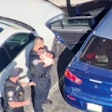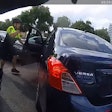In 1981, the U.S. Supreme Court issued a decision called New York v. Belton that spoke of setting down a "bright-line rule" for police searches of a vehicle following the arrest of a driver or passenger. The court said unequivocally: "We hold that when a policeman has made a lawful custodial arrest of the occupant of an automobile, he may, as a contemporaneous incident of that arrest, search the passenger compartment of that automobile."
The Belton ruling defined the proper scope of such a search as including the entire passenger compartment and any containers inside (but not the trunk). The word "container," according to the court, "includes closed or open glove compartments, consoles or other receptacles located anywhere within the passenger compartment, as well as luggage, boxes, bags, clothing and the like. Such a container may be searched whether it is open or closed."
In the 2004 case of Thornton v. U.S., the court went a step further and said that the Belton rule applied whenever a "recent occupant" was arrested, even though that person was already out of the car and walking away when contacted by police. The court rejected Thornton's argument that officers should not be allowed to make such a search once the arrestee was secured in the patrol car. The court said that adopting Thornton's proposed limitation on police officers would result in "potentially compromising their safety and placing incriminating evidence at risk of concealment or destruction." Declared the court: "The Fourth Amendment does not require such a gamble."
Only five years later, the court has reconsidered and has now decided to require just such a gamble.
Arizona v. Gant
During a narcotics investigation involving a Tucson residence, officers learned about an outstanding arrest warrant for resident Rodney Gant, for driving on a suspended license. When Gant arrived and parked in the driveway, he was arrested, handcuffed, and secured in the back of a patrol car. Officers then searched his car, finding a weapon and cocaine.
The trial court denied Gant's motion to suppress the evidence and he was convicted on two charges. On appeal, the Arizona Supreme Court reversed the convictions and the suppression ruling, finding that the search could not be justified as incident to arrest because Gant was secured before the search began. The court noted that the historical rationale for allowing searches incident to arrest was to prevent the arrested person from gaining access to weapons, destructible evidence, or the means of escape. Once the arrestee was secured and unable to retrieve any of these items from the vehicle, the rationale—and thus the justification for permitting a warrantless search—no longer applied, in the view of the Arizona Supreme Court.
On appeal by Arizona to the U.S. Supreme Court, the State argued that most jurisdictions have relied for the past 28 years on the "bright-line rule" of Belton, under which the search of Gant's car was lawful. Affirming the suppression ruling, the Supreme Court acknowledged this longstanding reliance, but decided nevertheless to replace the Belton "bright line" with a dimmer and more dangerous one: "Police may search a vehicle incident to a recent occupant's arrest only if the arrestee is within reaching distance of the passenger compartment at the time of the search or it is reasonable to believe the vehicle contains evidence of the offense of arrest."
The court sought to analogize Gant's vehicle search to the search of a house, as considered in the 1969 opinion in Chimel v. California. In Chimel, the court said that when a person is arrested inside a residence, the scope of search is limited to the area within the arrestee's immediate control; viewing the passenger compartment of a vehicle as being beyond the immediate control of a handcuffed arrestee who is locked in the back of a patrol car, the court ruled by a 5 to 4 vote that the search of Gant's car violated the Chimel rule.
Logicians and scholars will find much to criticize in the Gant decision. For example, Belton had expressly found that the passenger compartment is "generally, even if not inevitably," within an arrestee's reach. This generalization was said to satisfy the scope-of-search rule of Chimel. Also, the issue in Chimel was not whether a search incident to arrest could be conducted after a person was taken into custody and secured, but the scope of such a search; by contrast, the issue in Gant was not the scope of search, but whether officers could search Gant's car after securing him. Chimel does not address this issue.
[PAGEBREAK]
However, working police officers (unlike justices of the Supreme Court) must constantly and quickly assess unpredictable real-world situations where split-second choices not only could spell trouble for a criminal prosecution but might also threaten personal survival. You do not have the luxury of indulging in academic examinations of the reasoning fallacies committed by the courts. Your need is for understandable rules that you can apply on the street. Although Gant has changed the rules and left many unanswered questions, at least three aspects of the ruling seem to be discernible.
(1) You may still search a vehicle incident to arrest if the arrestee is not handcuffed and is within "reaching distance" of the passenger compartment of the vehicle. Obviously, this option is limited to situations where the person is arrested for a non-violent offense and you have no reason to believe he is armed or dangerous. Presumably, a back-up officer could watch an uncuffed arrestee (who might be seated on the curb next to the passenger door with his hands on his knees) while another officer completed the search. Of course, this technique should never be used at the risk of officer safety.
(2) You may still search a vehicle incident to arrest after securing a prisoner if the arrest is for the kind of crime that makes it reasonable to believe evidence of the offense may be in the vehicle. Examples could include driving while impaired, narcotics offenses, robbery, theft, burglary or drive-by shooting.
(3) You may still search within the scope of other justifiable exceptions to the warrant requirement, as established in other Supreme Court decisions such as:
-
Consent (Ohio v. Robinette)
- Probation or parole searches (U.S. v. Knights)
-
Officer safety searches (Michigan v. Long)
-
Public safety searches (Cady v. Dombrowski)
-
Impound inventory (Colorado v. Bertine)
-
Community caretaking (South Dakota v. Opperman)
-
Probable cause (U.S. v. Ross)
Civil Liability
In footnote 11 of the Gant opinion, the majority noted that since officers had been trained to follow the rulings of Belton and Thornton prior to April 21, 2009, they should not be subject to civil liability for searches conducted before that date in reliance on established law. After that date, however, officers and agencies could incur liability for vehicle searches incident to arrest that do not fall within the Gant guidelines. Because law enforcement training in most U.S. jurisdictions has long led officers to believe they could first secure any arrestee and then search the passenger compartment of his vehicle, it is important for all departments to ensure retraining based on Gant.
Devallis Rutledge is a former police officer and veteran prosecutor who currently serves as Special Counsel to the Los Angeles County District Attorney. He is the author of 11 books, including "Courtroom Survival, The Officer's Guide to Better Testimony."


















